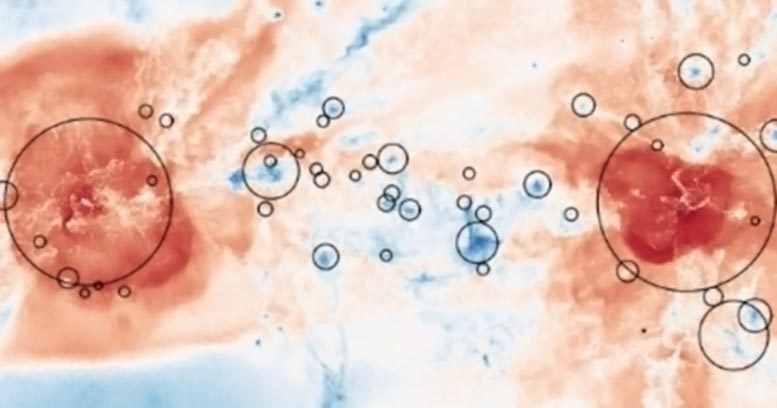
This animation shows the gas temperature in the IGM, looking through the sheet in-between the two main halos. Red colors are hot gas, while blue colors are cold gas. A shock wave is visible moving onto the forming sheet, causing the sheet to shatter, producing a multiphase mixture of hot and cold gas with granular morphology. Credit: Yale University
To understand the most ordinary matter in the universe — and the extraordinary things that happen to it — a Yale-led team of astronomers took a deep dive into the cosmic fog.
They learned intriguing new details about the dynamics of baryons, the collection of subatomic particles (including protons and neutrons) that accounts for much of the visible matter in the universe. Most baryons reside in the intergalactic medium (IGM), which is the space in-between galaxies where matter is neither bound to nor tugged upon by surrounding systems.
In a new study, Yale postdoctoral associate Nir Mandelker and professor Frank C. van den Bosch report on the most detailed simulation ever of a large patch of the IGM. For the first time, they were able to see how cold, dense gas clouds in the IGM organize themselves and react within much larger “sheets” or “pancakes” of matter in the vastness of space.
The findings, Shattering of Cosmic Sheets due to Thermal Instabilities: A Formation Channel for Metal-free Lyman Limit Systems, appear in the Astrophysical Journal Letters.
Researchers have tried for years to piece together the structures and properties of the IGM — in part to test the standard model of Big Bang cosmology, which predicts that 80%-90% of baryons are in the IGM, but also to investigate the IGM’s crucial role as the universe’s fuel source.
“The reason galaxies are able to form stars continuously is because fresh gas flows into galaxies from the IGM,” said Mandelker, lead author of the study. “It is clear that galaxies would run out of gas in very short order if they didn’t accrete fresh gas from the IGM.”
Yet detecting the IGM’s gas has been supremely difficult. Unlike galaxies, which shine brightly in starlight, gas in the IGM is almost never luminous enough to detect directly. Instead, it has to be studied indirectly, through the absorption of background light. Such absorption studies allow researchers to learn about the density and chemical composition of gas clouds; in particular, they’re able to find out if star formation in nearby galaxies has polluted the gas with metals (elements heavier than helium).
With its new simulation, the Yale team learned quite a lot — including new properties of those aforementioned sheets of baryons.
“These are flattened distributions of matter, known as ‘pancakes,’ that extend across many millions of light years across,” said van den Bosch. “We found that rather than being smoothly distributed, the gas in these pancakes shatters into what resembles a ‘cosmic fog’ made up of tiny, discrete clouds of relatively cold and dense gas.”
Such dense clouds of gas had been thought to form only in areas of space close to galaxies, where the gas is naturally denser. But the new simulation shows that they also can condense out of the low-density IGM. The researchers said the phenomenon occurs naturally, as the result of instability triggered by the efficient cooling of the gas.
This animation shows the gas temperature in the IGM, looking through the sheet in-between the two main halos. Red colors are hot gas, while blue colors are cold gas. A shock wave is visible moving onto the forming sheet, causing the sheet to shatter, producing a multiphase mixture of hot and cold gas with granular morphology.
Another aspect of this cosmic fog, based on the Yale simulation, is that it is pristine; it is too far away from any galaxy to be polluted with metals. According to Mandelker, this is significant because it explains recent, puzzling observations of dense, metal-free clouds at large distances from galaxies. Astronomers could not explain this phenomenon, but the new simulation suggests their presence may simply be the outcome of a natural process.
“Our work highlights the importance of properly resolving the properties of gas in the IGM, which is often neglected in favor of better resolving the central galaxies,” Mandelker said. “It has been very difficult to understand how the gas in the IGM could possibly become so dense and optically thick, especially when previous generations of cosmological simulations did not reveal any such dense gas in the IGM.”
Mandelker is a Tschira Postdoctoral Fellow in a collaborative program in astrophysics operated by Yale and the Heidelberg Institute for Theoretical Studies (HITS). The principal investigators of the program are van den Bosch and Volker Springel of HITS, who is a co-author of the new study. Freeke van de Voort of the Max Planck Institute for Astrophysics also is a co-author of the study.
The research was supported by the Klauss Tschira Foundation through the HITS Yale Program in Astrophysics and a grant from NASA.
Reference: “Shattering of Cosmic Sheets due to Thermal Instabilities: A Formation Channel for Metal-free Lyman Limit Systems” by Nir Mandelker, Frank C. van den Bosch, Volker Springel and Freeke van de Voort, 9 August 2019, Astrophysical Journal Letters.
DOI: 10.3847/2041-8213/ab30cb

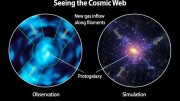
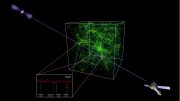

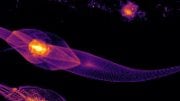
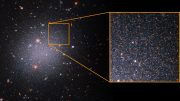
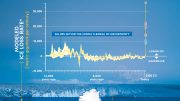
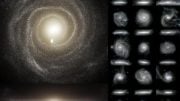
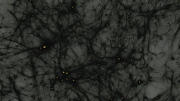
With all the talk about this singular bang that created everything we can observe, is there a known definitive origin of the bang in 3D space relative to our planet an solar system? Just wondering, how fat away from Earth the Big Bang occurred…. what occupies that position today and where are we now relevant to that original transmission?? and how far away is it from us now and how fast is it expanding away from its center still?
Citation: dark matter islands formed may assist for a diagonolised hoping to increase the super conductivity
The relationship between charge density waves and superconductivity? It’s complicated and dark matter islands formed may assist for a diagonolised hoping to increase the super conductivity by a square lattice geometry
Since helium is free of impurities, such as dark matter these Cooper paired electrons are expected to retain quantum states longer than in any other materials, But a square lattice formation may give way to diagonal hopping behavior enhancing Cooper pair effect of super conductivity.This means a form of symmetry enhances the super conductive coupling continuity disturbed during variations in temperature and realign at critical temperatures
For a long time, physicists have tried to understand the relationship between a periodic pattern of conduction electrons called a charge density wave (CDW), and another quantum order, superconductivity, or zero electrical resistance, in the same material. Do they compete? Co-exist? Co-operate? Do they go their separate ways?
For the first time, physicists at Ames Laboratory and their international collaborators were able to explore that relationship in the superconducting and CDW material niobium diselenide (NbSe2), through experiments using swift electron bombardment. The research, which included resistivity measurements, London penetration depth studies, and X-ray diffraction, showed that the relationship between CDW and superconductivity is complicated — in some ways the two states compete with each other, and in others, CDW assists superconductivity. “As CDW is suppressed or disrupted, superconductivity is grabbing the electrons needed to form Cooper’s pairs, which form superconducting condensate.” But CDW also assists superconductivity through its coupling to crystal lattice vibrations, called phonons. And phonons act as a “glue” between electrons to form a Cooper pair. At critical temperature but also is broken by critical magneticfield intensity along triple spin behavior in forming charges becoming polesAt some threshold level of disorder, long-range ordered CDW disappears abruptly, and superconducting transition temperature is abruptly reduced as well.
The simulations they ran, published in Science today, suggest that researchers might be able to toggle superconductivity on and off in copper-based materials called cuprates by tweaking their chemistry so electrons hop from atom to atom in a particular pattern – as if hopping to the atom diagonally across the street rather than to the one next door. This study focused on the delicate interplay between two phases that are known to exist in cuprates – high-temperature superconductivity and charge stripes, which are like a wave pattern of higher and lower electron density in the material. When electrons hopped only to their immediate neighbors on the square lattice, the pattern of charge stripes got stronger and the superconducting state never appeared. When electrons were allowed to hop diagonally, charge stripes eventually weakened, but did not go away, and the superconducting state finally emerged that is what is really happening in Mars topological surface
Prof. Denis Konstantinov and his collaborators, Kawakami and Dr. Asem Elarabi, placed a parallel-plate capacitor inside of a copper cell cooled to 0.2 degrees Kelvin (-272.8 degrees Celsius) and filled with condensed liquid helium. Electrons generated by a tungsten filament sat atop the liquid helium’s surface, between the two capacitor plates. Then, microwave radiation introduced into the copper cell excited electrons’ quantum states, causing the electrons to move away from the bottom capacitor plate and come closer to the top capacitor plate. A magnet (ytterium iron garnet; YIG) and a superconducting qubit are placed with a separation of 4 cm. The electric field in the cavity interacts with the qubit, while the magnetic field interacts with the magnet. At an extremely low temperature of around -273 degrees centigrade, magnons, i.e., quanta of the fluctuations in the magnet, coherently couple with the qubit through the electromagnetic field of the cavity.
• “A Jupiter-Mass Companion to a Solar-Type Star”, Mayor, M., & Queloz, D. 1995, Nature, 378, 355. (2300 citations).
• “ELODIE: A spectrograph for accurate radial velocity measurements”, Baranne, A., Queloz, D., Mayor, et al., 1996, , Astronomy and Astrophysics Supplement Series, 119, 373. (771 citations).
• Queloz, D.; Mayor, M.; Weber, L, et al. 2000, “The CORALIE survey for southern extra-solar planets. I. A planet orbiting the star Gliese 86”, A&A354, 99 (250 citations)
• Queloz, D., Eggenberger, A., Mayor, et al. 2000, “Detection of a spectroscopic transit by the planet orbiting the star HD209458”, Astronomy and Astrophysics, 359, L13. (259 citations).
• The effect of red noise on planetary transit detection, Pont, F.; Zucker, S.; Queloz, D., 2006, MNRAS 373, 231 (373 citations).
• “The CoRoT-7 planetary system: two orbiting super-Earths”, Queloz, D.; Bouchy, F.; Moutou, C. et al., 2009, A&A 506, 303 (279 citations)
• The HARPS search for southern extra-solar planets. XIII. A planetary system with 3 super-Earths (4.2, 6.9, and 9.2 Me), Mayor, M.; Udry, S.; Lovis, C.; Pepe, F.; Queloz, D.; Benz, W.; Bertaux, J.-L.; Bouchy, F.; Mordasini, C.; Segransan, D., 2009, A&A 493,639 (232 citations).
• “WASP-8b: a retrograde transiting planet in a multiple system”, Queloz, D, Anderson, D. R.; Collier Cameron, A. et al., 2010, A&A517L, 1 (93 citations).
• “Spin-orbit angle measurements for six southern transiting planets. New insights into the dynamical origins of hot Jupiters”, Triaud, A. H. M. J.; Collier Cameron, A.; Queloz, D, et al. 2010, A&A…524A.25 (318 citations).
• Search for brown-dwarf companions of stars, Sahlmann, J.; Ségransan, D.; Queloz, D.; Udry, S.; Santos, N. C.; Marmier, M.; Mayor, M.; Naef, D.;Pepe, F.; Zucker, S., 2011, A&A525,95. (109 citations)
• “Planets and stellar activity: hide and seek in the CoRoT-7 system”, by Haywood, R. D.; Collier Cameron, A.; Queloz, D.et al., 2014, MNRAS, 443, 2517 (138 citations).
• “Temperate Earth-sized planets transiting a nearby ultra-cool dwarf star”, Gillon, M. and Jehin, E., Lederer, S.M. and Delrez, L., de Wit, J., Burdanov, A., Van Grootel, V., Burgasser, A.J. Triaud, A.H.M.J., Demory, B.-O. Sahu, D.K., Bardalez Gagliuffi, D. Magain, P., Queloz, D., 2016, Nature 533, 221. (199 citations
Journal Reference:
1. Kyuil Cho, M. Konczykowski, S. Teknowijoyo, M. A. Tanatar, J. P. Guss, P. B. Gartin, V. Mishra, P. J. Hirschfeld, R. Prozorov. Using controlled disorder to probe the interplay between charge order and superconductivity in NbSe2. Nature Communications, 2018 [link]
2. Erika Kawakami, Asem Elarabi, Denis Konstantinov. Image-Charge Detection of the Rydberg States of Surface Electrons on Liquid Helium. Physical Review Letters, 2019; 123 (8) DOI: 10.1103/PhysRevLett.123.086801
3. Y. Tabuchi, S. Ishino, A. Noguchi, T. Ishikawa, R. Yamazaki, K. Usami, Y. Nakamura. Coherent coupling between a ferromagnetic magnon and a superconducting qubit. Science, 2015; 349 (6246): 405 DOI: 10.1126/science.aaa3693